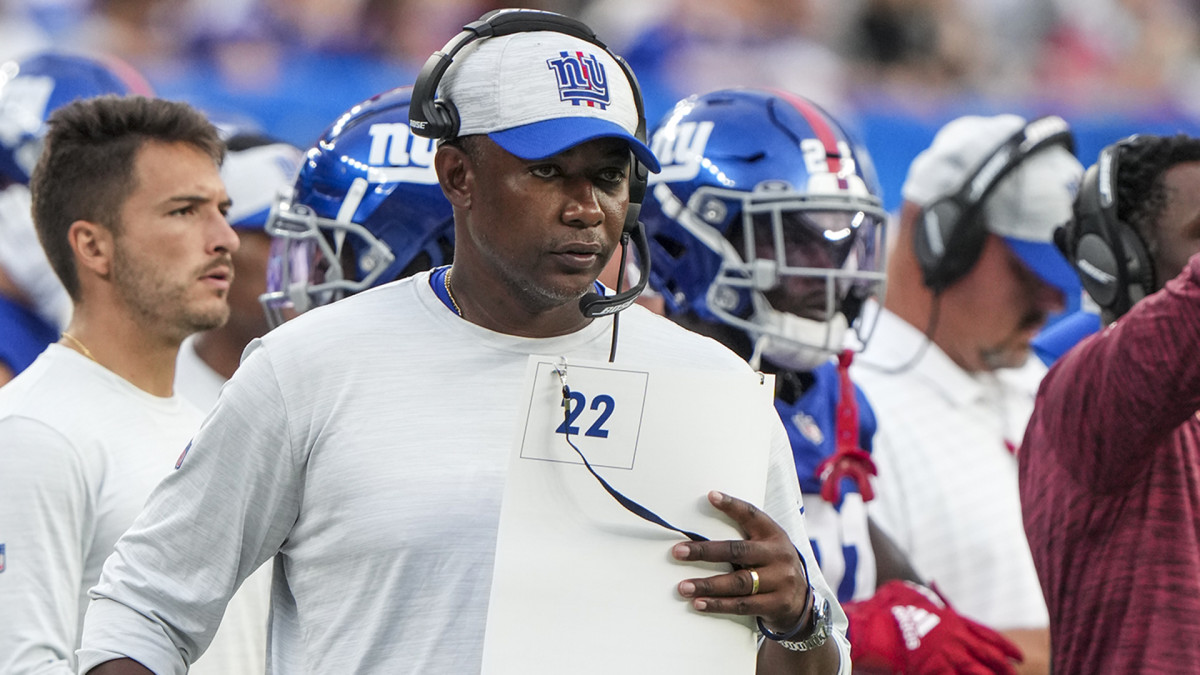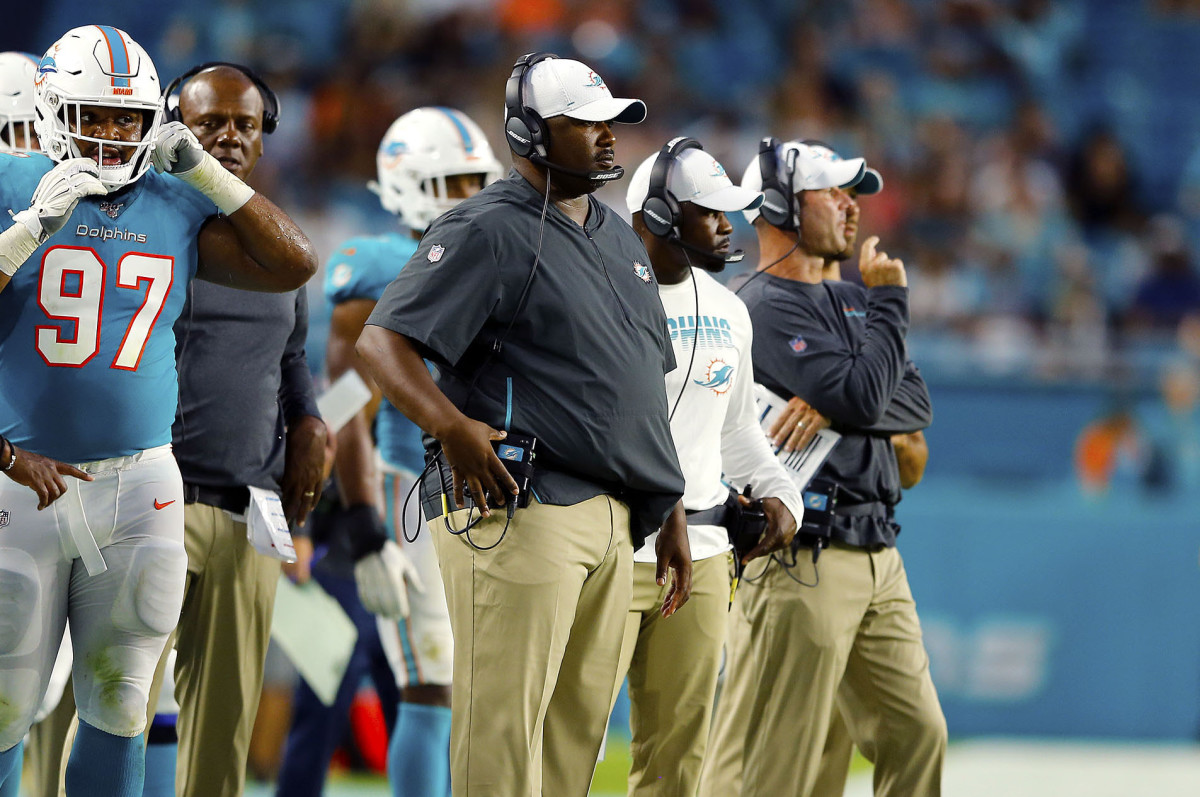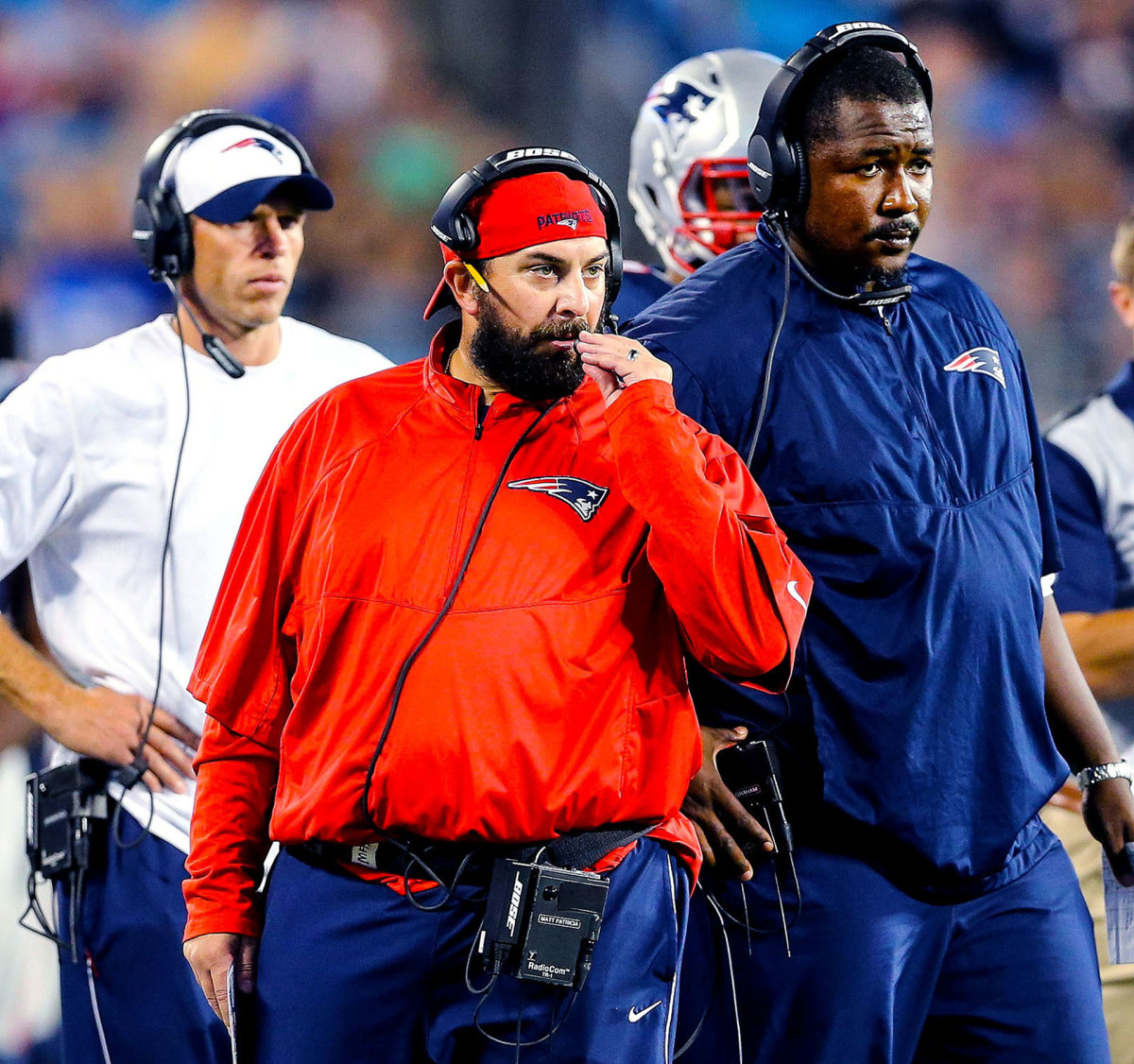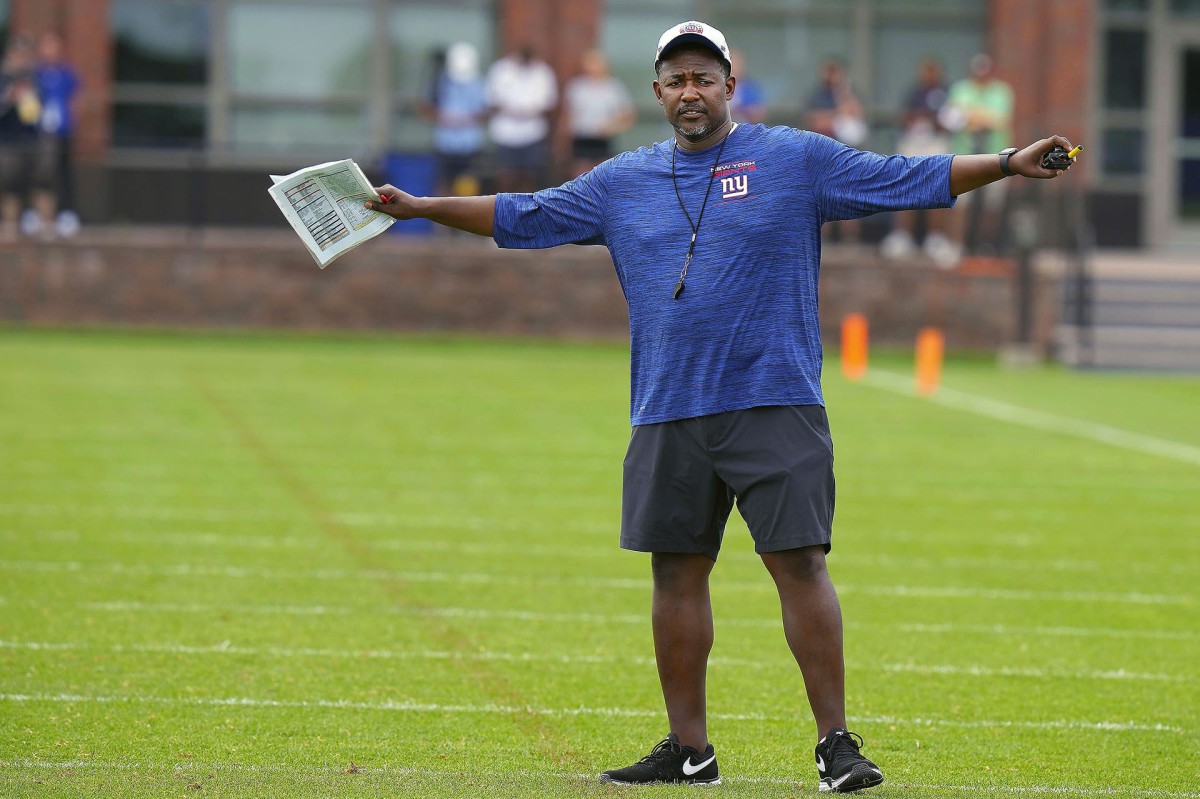Patrick Graham Is Creating a Defensive Masterpiece
Because all’s fair in love and draft evaluations, the Black Picasso agrees to partake in an exercise he’d rather avoid. O.K., he says, bring on the dreaded self-evaluation. He’ll provide a scouting report for a young pass rusher from Yale, class of 2001. But rather than re-live some distant glory, he’ll illuminate how he ended up in the last job he ever expected to take.
Natural defender/+ strength/bends at waist/plays high/late with hands/poor in transition. And, the kicker: arguably the slowest Black man who ever played football.
Funny story. He says this all the time, his life unspooling with self-deprecating anecdotes, small injections of levity. It’s his senior season, 2000, years after he converted from tight end to D-line and lifted enough weights to actually run onto the field. He registers a pressure, and he’s feeling himself, out there against Fordham. But on the very next play, overconfidence oozing, he misses his assignment, failing to reach the A Gap, let alone close it. A waterfall of obscenities rushes from the mouth of his position coach, Duane Brooks. “Motherf-----!” Brooks screams.
He wishes he could shrink, hide, enter witness protection. He still can’t believe what he does instead: He argues what he knows isn’t true, insisting he had completed his assignment. He also remembers, vividly, the reaction. Brooks is a dormant volcano that has just become active, furious and bubbling, hands reaching out for neck. His neck.
“I’m never going to be like that,” he thinks, meaning a coach capable of such rage. He believes his future lies in the CIA, with reasonable bosses. But then Brooks puts him back in, and he plays beyond his capabilities, making tackles, dropping a back behind the line. He dislocates his shoulder the same day, unfortunately. But that is how, in the same afternoon, he registers both the apex and end of his college career, despite—and because of—one very angry, soon-to-be lifelong mentor. What a trifecta. He figures football has ended for him that day on that field.
But Brooks will float a silly notion, one that makes him laugh.
“You’re going to be a coach.”
The whole thing is, well ... funny story.
Throughout this spring and summer, over several phone calls and text message threads, the accidental football coach spins yarns to Sports Illustrated. He’s Patrick Graham, if that’s not clear already, the clipboard-holder who would help stage an NFL counter-evolution. Funny story, he says repeatedly, to explain his trajectory, his philosophy, or the implausible nature of his existence.

He starts here: There’s no order, no logic to the career ladder that the Black Picasso climbed. His wife, Pamela, likens the uneven route to a circuitous jungle-gym. Another way to look at it is Dippin’ Dots thrown at a dart board. There’s the tough-love coach, the trash-talking teacher, the stunned guidance counselor, the TV show Girlfriends, a towed car, a borrowed truck, Skin-So-Soft lotion, bottle caps, pet cockroaches, long walks to work, longer nights cutting up game film, a Stage-Five Clinger, a Giants legend, an incubator for defensive acumen and an NFL icon who heard click. Some of this will make sense. Eventually.
It took years for the man himself to understand. “Oh, hell no,” he says, when asked if he expected to end up anywhere near here until recently. Not at this age (41), with this title (Giants defensive coordinator/assistant head coach) and the nickname born for his masterpiece game plans. Certainly, he didn’t see the evolution coming, not in those years when hearts across the NFL fluttered over young offensive wunderkinds, the Sean McVays and Kyle Shanahans and Matt LaFleurs obscuring the defensive geniuses who would rise up in opposition, fighting for balance, for the soul of pro football, in a game long tipped toward points. Consider defensive wizards like Graham, Brandon Staley (Chargers) and Robert Saleh (Jets) the last hopes to prove that a fading maxim—defense wins championship—still rings true.
Graham remembers every stop, because he needed to take every one of them: Wagner, Richmond, Notre Dame, Toledo; the Patriots, Giants, Packers and Dolphins, then back to the Giants, to take everything he learned and put it all together. He was young and unproven, and his 2019 Dolphins, the first unit he oversaw with a defensive coordinator title, finished 30th in total defense. But he was also smart (Yale), pedigreed (Patriots) and part of the family at a franchise where that matters.
In 2020, he inherited a makeshift Giants defense consisting of mostly young players, unproven players, unwanted players or some combination of all three. The ever-friendly New York media greeted his presence with typical skepticism, pegging that unit, specifically, as a major problem for one of the league’s worst teams.

Funny story. Hilarious in its hubris. He doesn’t view this task as unusual, unfixable, or impossible. He had scratched, begged and pushed through worse. Instead, he headed where he always goes to brainstorm, to his office, aka The Lab, where he cranks Talib Kweli, The Roots and Outkast and begins his football sketches. Various sharpies sit in a cup nearby, in front of two bookshelves stocked with volumes on leadership and mental fortitude, near the white board that’s always covered in ink.
This is where he drew up the game plan that altered the trajectory of Seahawks quarterback Russell Wilson’s season; where he almost manifested an improbable playoff berth, guiding a flawed defense beyond any reasonable expectation, finishing 2020 ranked 12th in total D (349.3 yards), ninth in scoring D (22.3 points) and eighth in defensive efficiency. With improvements that striking—borderline miraculous—he began fielding calls from franchises in the market for head coaches, which he parlayed into a promotion, an extension and a raise.
Then, it’s back to The Lab. There’s another season to prepare for. Perhaps his last as an assistant coach.
Funny story, naturally: Before the Black Picasso painted his first brushstroke onto a white board, he began training for a football evolution he didn’t know existed. Graham devours Tom Clancy novels, studies spy movies and picks up complex math and science concepts with ease. He’s a “nerd-in-training,” meaning he’s analytical, comfortable with numbers and processes—long before teams embrace those exact traits in their football coaches.
On the first day of his freshman year at Crosby High in Waterbury, Conn., he marches into the office of Mrs. Austin, his new guidance counselor, weeks before he’s scheduled to check in. He’s tall, about 6' 3", and skinny, at 175 pounds. He’s an athlete but not a star one. His father, Larry, works at a mental health facility, while his mother, Liz, takes customer service calls for a gas company.
He ignores the shock registered on her face as he announces a plan which, with his good-but-not-great academic credentials, seems at best delusional. “Mrs. Austin,” he says, “my name is Patrick Graham. I’m a freshman. I’m either going to Yale or Duke. And we’re just going to have to figure out how to get that done.” She laughs. He laughs. This plan doesn’t make any sense, and yet, it’s impossible not to believe him.
He’s the middle of three Graham boys. All would play sports in college, but he’s the least athletically inclined. He keeps to himself, likes reading in his room. He’s shy, quiet, smart and studious, with the exception of one rebellious stretch in eighth grade. He complained loudly in science class one day, about how the private schools nearby rejected his applications, and his teacher, Ms. Hayes, asked him to quiet down. He ignored her, and she yelled, “Patrick, that attitude right there is the reason you didn’t get in! And you wonder why!” Stunned into silence, he realized: She was right. With the assistance of the guidance counselor and the teacher, the plan began to take shape.
He aced honors classes for gifted students. He ran for class president all four years, winning each time. He took Advanced Placement classes, everything from chemistry to literature-and-composition, played football and basketball, attended church and applied to Yale, early decision. He was accepted. Mrs. Austin announced the news over the school intercom.
He became a Bulldog. Won an Ivy League title in ’99. Tried majoring in chemical engineering but found the courses unnecessarily complicated, then switched to sociology, with concentrations in economics and African-American studies.
The university’s tree-lined campus provided its own laboratory of sorts. Most students came from more privileged backgrounds; very few collected the pink slips that warn them to pay one bill or another to stay enrolled, like Graham did. The football roster, he says, included maybe five Black players. He learned how to reach people who are from different places and run in different circles and learn in different ways. The sociology background helped him understand team dynamics; this is more training he didn’t recognize at the time. His teammates pushed him to be less reclusive, to reveal more of himself. He opened up, graduated and headed to Cincinnati with his girlfriend.
He moved there in ’01, in the middle of a heatwave. He owned one suit. He donned it every morning, anyway, heading downtown in his girlfriend’s Honda Accord to look for work. When he ran out of applications to complete, he grabbed temp hours, applying Avon’s Skin-So-Soft lotion to strangers’ arms, peddling Banana Republic sweaters and twisting caps onto bottles in an ointment factory.
His relationship soured, which meant no more car and, eventually, no more girlfriend. He found work as a PR consultant, penning articles about slicers, scales and machine parts. It was boring, but it paid, and it showed him that he’s capable of anything, that he could find a way.
To make 8 a.m. meetings, he rose at 4:30, dressed quickly and caught several buses, the last of which dropped him off two miles from his desk. He walked the rest of the way, at least until a kind co-worker noticed him slogging down a busy street in the rain one day, wearing the only suit he owned.
Funny story. Her husband manages a minor-league baseball team, and she loans him their truck when possible, even teaches him how to operate a stick-shift during lunch breaks. Through her kindness, he understands how vulnerability leads to trust.
Still, he calls Brooks often to complain, about the temp jobs, the failed relationship, the mundane life.
“Time to coach,” Brooks tells him. “You know everything. You’re a super nerd, a f---ing computer.”
“F--- no,” he responds.
He was driving home from work, almost two decades later, when he said those two familiar words once more. Funny story. Pat Graham has a million of these stories. They’re how he tells the larger story of his life.
He does listen to Brooks, eventually, but mostly because by joining the football staff at Wagner, a Division I-AA program in Staten Island, N.Y., he can obtain an MBA for free. Maybe the CIA will like that, he reasons, or he can work on Wall Street and tell tall tales from his days on the sideline.
On his very first shift, in the fall of ‘02, he begins to realize all the clipboard life entails. He’s a recruiter, a weight room advisor, an academic coordinator and an actual coach, whenever time permits, sometimes even for the JV squad. He maps out the study hall and weight room schedules. He launders jerseys and takes out trash. He starts his days at 7 a.m. and doesn’t finish until after 9 p.m. workouts. This workaholic existence long known to football people as “coaching” makes him want to move on even more. But in the weeks that follow the strangest thing happens: He starts to love it.
One afternoon, out on the practice field, a Wagner D-lineman misses an assignment and makes an excuse, pulling a Yale/Graham. He goes full Brooks, flipping out, losing his mind. Suddenly he understands -- both what Brooks had been trying to do and why it had worked in ways he could never have foreseen. Brooks was coaching: wanting him to be better, but pushing him, nonetheless.
That day, he finds his future, and it’s not an advanced finance degree. He wants to coach. He tells that to Brooks, and they share the longest laugh.
His siblings, the better athletes in the family, end up with secondary degrees hanging from their office walls. The self-described “nerd” does not. He’s still one unfinished class short of that MBA, meaning he chose an advanced education in defense and the most unglamorous life in sports.
At Richmond (’04), he made $10 per hour. His “free housing” meant a twin bed stuffed into an old closet near the equipment room inside the basement of the university’s basketball gym. He lived there with two roommates and a pair of pet cockroaches. “Bill” and “Mary,” the coaches called them.
He met a girl. Funny story: He saves pennies for months, actual pennies, until he can drive home to Connecticut to visit family at Christmas in ‘05. But his car is towed the night before he’s leaving, and his savings vanish at the impound lot. He cancels on his parents, goes to another party and meets Pamela, the woman whose support will make possible his sacrifice. But he also feigns an interest in Girlfriends, the UPN drama she watches obsessively. He will study the show, searching for excuses to contact her. Again: whatever works.
He moved on to Notre Dame, a dream job, dream wife now in tow. His new boss, Charlie Weis, stared at him the first day, then asked, in front of everyone, what’s wrong with him. He can still hear Weis, the sarcasm. “Why aren’t you on Wall Street?”
Because this is better. He knew that.
This connection, to Weis, leads to his next story, one that’s not just funny but comical.
Graham still can’t recall all the particulars, not in 2020, looking so far back. But he remembers that it happened, this call he takes in ’09, from a number with a New England area code, the voice on the other end so monotone he thinks it must be fake. Bill Belichick introduces himself, and Graham actually laughs, thinking, nice try, to whomever might be pranking him. Then, click.
He hangs up on the greatest coach in football history.
He calls Brooks, who wants to reach for his neck again, who tells him to call back and tell Belichick he’ll do anything. He does all that, just as instructed, and Belichick offers the lowest-level gig in pro football: defensive quality control assistant. This means starting over, more or less, but he sees the opportunity hidden beneath the grunt work. He knows that no coach in modern football can match Belichick’s brain, especially for defensive schematics. He doesn’t care about the surliness Belichick often projects publicly; he believes what Weis tells him, that the Patriots czar treats his meeting rooms like tech incubators, encouraging innovation and ideas from everyone, regardless of title or tenure.
Offensive football is exploding then, just as the McVay/Shanahan/LaFleur wunderkinds are getting started. Belichick sees what’s coming but clings to his counterintuitive nature, doubling down on defense, trading stars like Randy Moss and letting Tom Brady handle those pesky things called points with patchwork offenses.
Boss Hoodie put him right to work, piling on every task but cutting the sleeves off those game-day sweatshirts. His least favorite is called “padding,” where he must watch tape of upcoming opponents and draw out every play, noting receiver splits, o-line tendencies and intention, and he must do this for up to five games every week. On his best day, this padding takes seven hours; usually, much more. Sometimes, Pam helps until 2 a.m., nudging him every time he nods off, scissors slipping from his grasp.
All the padding serves another purpose, teaching him to look at football like his boss does. Both know the NFL altered rules to favor offenses. He watched as they borrowed concepts from the college game, spreading out targets, speeding up huddles, incorporating designed runs and varying game plans week by week.

The important thing he notices: most defensive specialists don’t adjust like Belichick. They use a base structure, either 4-3 or 3-4, with varied coverages and fronts mixed in. His boss changes every week, beginning to play more nickel and dime coverages, sometimes even on first down, before that wrinkle becomes an NFL staple. He collects versatile defensive backs to counter the addition of so many wideouts and rotates players all over the field.
Graham watched all this closely, cognizant of an invaluable experience. Belichick taught him that flexibility matters far more than convention, that moveable pieces yield confusion when they’re shifted around, that good football players should shape elite defenses based on their individual strengths, rather than the other way around.
Belichick encouraged staff members to meet regularly just to brainstorm, and Graham began dropping by the offices of future head coaches: Brian Flores, Matt Patricia, Mike Vrabel, Joe Judge. He calls them “fundamentalists” in that they approached football from a purist standpoint, the focus trained on situational awareness, fundamentals and creativity.
Another assistant, Pepper Johnson, becomes a mentor, urging him to pop by, sit silently, study, observe. They call these sessions Football 101. Sometimes, Johnson told stories about the exacting nature of playing for Belichick on the fearsome Giants defenses from the 1980s. The more the NFL changed, Johnson told him, the more Belichick pivoted the other way.
He shut up. He listened. Johnson noticed that Graham wasn’t “trying to get over,” wasn’t attempting to climb at someone else’s expense. He wanted to learn. Perhaps it’s blasphemous, but in some ways, he reminded Johnson of Belichick, in the way his brain worked, the analytical bent and the willingness to innovate.
Together, they triumphed over the Seahawks in Super Bowl XLIX, because of a play drawn up in one session earlier that week. That night, at the Wild West-themed party in Arizona, Graham considered all the random events he threaded together to stand right there, an NFL champion. He still had no idea how prepared he was for what seemed to be ahead of him. He didn’t yet know that Judge would take over the Giants in 2020 and need a defensive overhaul, meaning Judge’s first call went to his old office neighbor. The analytical one who sought peace not on a beach, but in that Lab.
There’s a contrast to his 2020, the gulf between a world that descends into chaos and his specific orbit, where everything he’s learned—and everything he went through—aligned to show him what’s possible, what’s next. He found an order, balance. He was aware, of course, of the compliments, of players like Logan Ryan coining nicknames like the Black Picasso, or The Computer, how pundits pegged him for open jobs. But he now saw himself in the one light he never expected: as a coach, simple as that.
He needed every step to arrive here, to prepare for the overhaul and the counter-evolution. Funny story. Of course. In 2014, after a rookie season diminished by injury, Ryan learns he’s slated for heavy duty in the Patriots’ fourth preseason contest. Ryan wonders if he will be cut. But just before kickoff, Graham tells the corner that he will call plays that afternoon to highlight Ryan’s strengths. He follows through. Ryan sticks and starts 27 games for New England over the next two seasons. And when his old coach calls the free agent corner in 2020, Ryan tells Graham to save the pitch for someone else. “I’m going to be a Giant because of that fourth preseason game,” Ryan tells him.
Ryan helped him implement a New England ethos. Graham’s schemes changed weekly, often drastically, based in part on analytics gleaned from offensive trends. He didn’t teach by shouting the way that defensive coaches of yesteryear preferred. Instead, he explained his scheme through an odd concept: math.
He told players to divide football fields into grids, then explained his spots-and-dots theory to defensive supremacy. Spots meant the way he split up fields, into squares within a larger grid, the overall size on any one play dictated by how much ground must be defended. The players themselves become dots, and they’re assigned to cover one spot, or several in the same part of a grid.
The versatility he embraced allows him to become even more creative. He moved Ryan to safety, but also into the nickel corner role, or sent him on a well-timed blitz. Since Ryan rarely lined up in the same place, all the shifting gave fewer clues to opposing quarterbacks, which meant more confusion, as spots change and dots shift. His defenses played in 3-4 alignments and 4-3 ones. They switched from man to zone to hybrids of both. They defended Tom Brady (disguised coverages) far differently than Andy Dalton (make him throw deep), installing upwards of 25 new packages every week, even after near-perfect ones.
He also encouraged players to diagram their own ideas, the same task Belichick once gave to him. He called one play Ryan drew up on a napkin against Washington, and Ryan netted an interception, before calling his coordinator a “savant” and a “genius,” another masterpiece complete.
After an 0–5 start, his defense held the next 11 opponents to no more than 27 points. Six teams in that stretch failed to put 20 on the board. The Ryan pick from the napkin diagram, in Week 9, saved a late victory. The plan that bottled Wilson and the Seahawks in Week 16—take away deep threats, clog rushing lanes, force checkdowns and short passes—changed the league MVP race, snagging the G-men another upset. “Russell was the MVP,” Logan says, “and then, after us, he wasn’t.”
Graham deflects credit, just like Belichick taught him. But NFL decision makers noticed, and he shot up the hotshot coordinator lists. Linebacker Blake Martinez says he’ll never let him go. Stage-Five Clinger, for life. The more optimistic fans began clamoring for a return to the days of dominant Giants defenses, the ones primed by another desirable assistant who seemed destined to rule his own football kingdom: Belichick.

Perhaps the Giants will now shock the NFL again, with a playoff run, with Saquon Barkley set to return from injury, Daniel Jones better from experience and that D stocked with four new players from the draft. Already, Graham is back in the Lab, concocting wrinkles, preparing for the season opener against the Broncos.
It’s here, now, in that studio, hip hop cranking, sharpie in hand, where he fights to regain the balance that once defined pro football—or develop carpal tunnel trying. Brooks wonders if the player who once infuriated him now needs a “consultant-slash-snitch.” Graham can’t help but laugh at the suggestion, the symmetry, on the eve of another football season, the one he hopes will remind a nation of fantasy football GMs that defense can matter as much as touchdowns.
Perhaps he can write his own story. He might start with: Once upon a time, in a world dominated by passing, an important gridiron revolution began, led by the accidental football coach … This would, of course, be a funny story.
More NFL Coverage:
• Dak Prescott’s Heal Turn
• Sammis Reyes: The NFL’s Unlikeliest Tight End
• Why Copying the NFL’s Trendiest Offense Is Harder Than You Think
• How the Bucs Are Leading the Linebacker Revival
